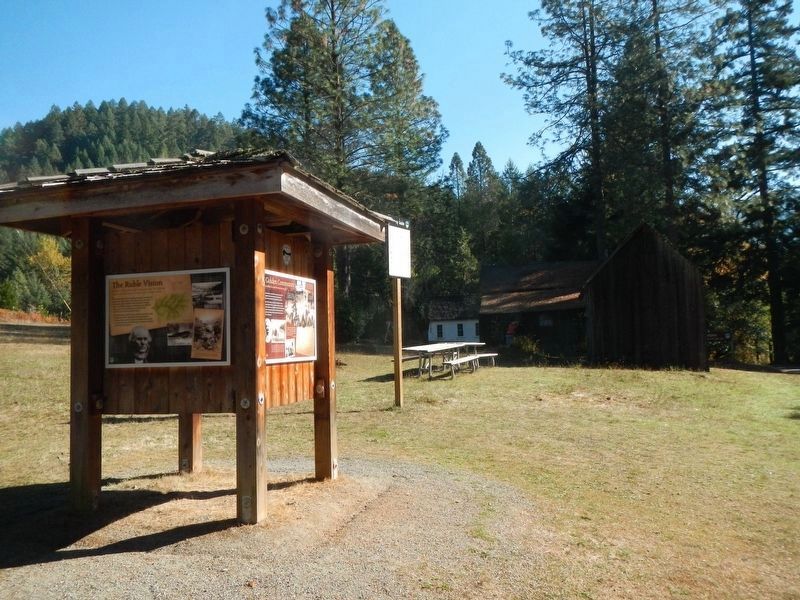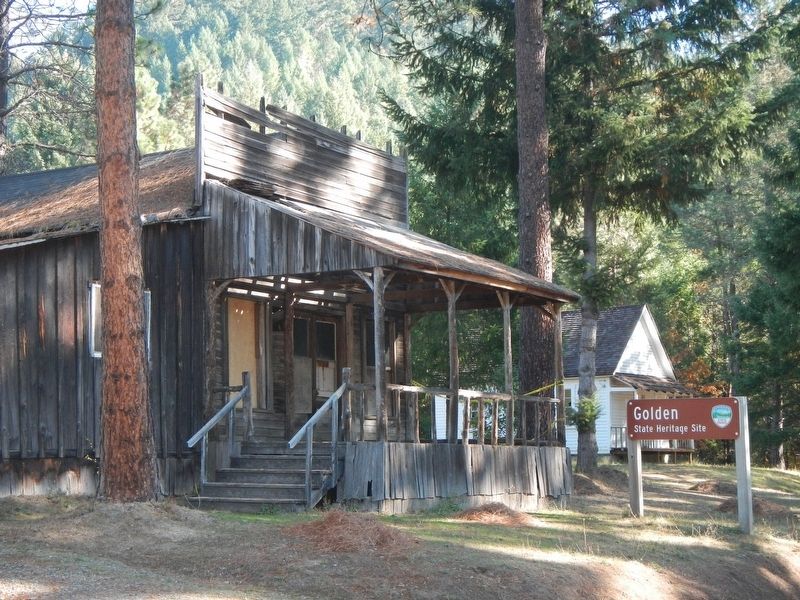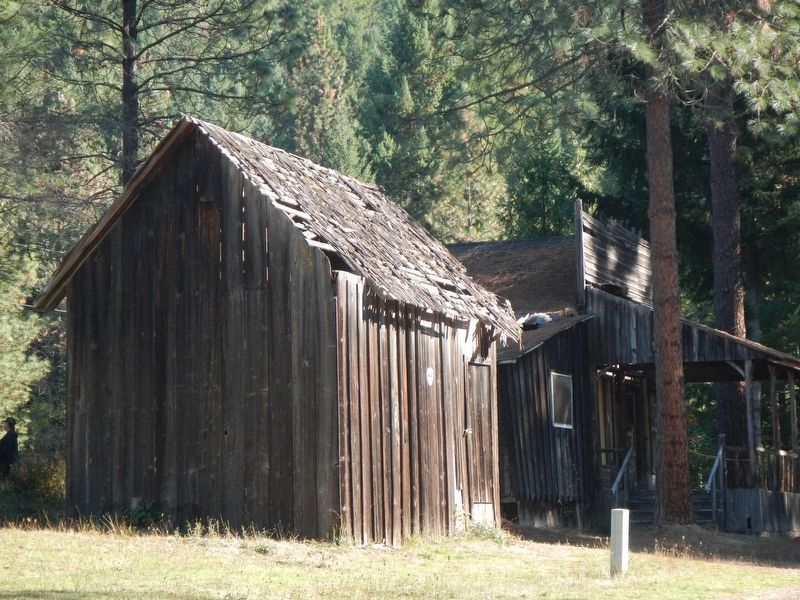Near Wolf Creek in Josephine County, Oregon — The American West (Northwest)
GOLD!
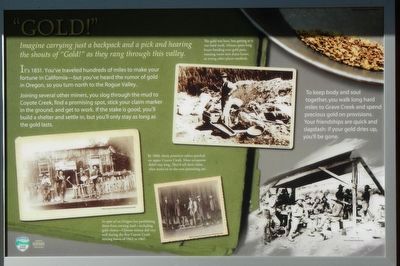
Photographed By Barry Swackhamer, September 27, 2017
1. GOLD! panel
Captions: (top center) The gold was here, but getting at it was hard work. Miners spent long hours bending over gold pans, running water into sluice boxes, or trying other placer methods.; (middle left) By 1860, thirty privative cabins perched on upper Coyote Creek. Most occupants didn't stay long. They'd sell their claim, then move on to the next promising site.; (bottom center) In spite of an Oregon law profiting them from owning land - including gold claims - Chinese miners did very well during the first Coyote Creek mining boom of 1862 to 1867.
It's 1851. You've traveled hundreds of miles to make your fortune in California - but you've heard the rumor of gold in Oregon, so you turn north to the Rogue Valley.
Joining several other miners, you slog through the mud to Coyote Creek, find a promising spot, stick your claim marker in the ground, and get to work. If the stake is good, you'll build a shelter and settle in, but you'll only stay as long as the gold lasts.
To keep body and soul together, you walk hard miles to Grave Creek and spend precious gold on provisions. Your friendships are quick and slapdash: if your gold dries up, you'll be gone.
You know there's gold, right under your feet. But without a more powerful way to extract it your dream will die.
Seventeen years after the gold rush began, miners were using creek water under high pressure to process soil and extract gold, a method called hydraulic mining. New arrival William Ruble was struck by how efficient the process was. He bought up several claims, sent for his sons, and started to work.
But the Rubles couldn't move soil fast enough to make a profit, and when creek water levels dropped in summer, they couldn't work at all. Rather than giving up and moving on, the Ruble sons invented a solution: the Ruble rock elevator.
Listen carefully. Can you hear the voices of the past?
Mothers, fathers, and children walked up the church steps together many times each year, gathering for worship and encouragement in good times and bad.
In the late 19th century, rough-and-ready boom towns spring up wherever their was gold, and just as quickly faded away. Golden was different. With the Ruble elevator bringing in a constant profit, the 1890s found Golden growing into a thriving, family-centered community of more than 100 people.
Erected by Oregon State Parks.
Topics. This historical marker is listed in these topic lists: Industry & Commerce • Settlements & Settlers.
Location. 42° 40.92′ N, 123° 19.872′ W. Marker is near Wolf Creek, Oregon, in Josephine County. Marker is on Coyote Creek Road near Bear Gulch Road, on the left when traveling east. Touch for map. Marker is at or near this postal address: 3482 Coyote Creek Road, Wolf Creek OR 97497, United States of America. Touch for directions.
Other nearby markers. At least 8 other markers are within 4 miles of this marker, measured
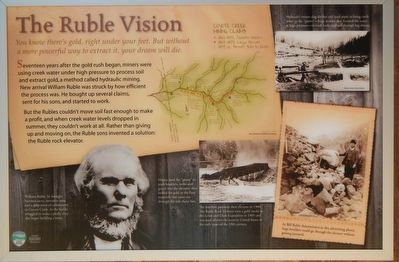
Photographed By Barry Swackhamer, September 27, 2017
2. The Ruble Vision panel
Captions: (bottom left) William Ruble, Sr. brought business savvy, inventive sons, and a deep sense of community to Coyote Creek. As the family struggled to make a profit, they also began building a town.: (bottom center) Miners used the "giants" to push holders, rocks and gravel into the elevator, then looked for gold in the finer materials that came out through the side sluice box. The brothers patented their elevator in 1900. The Ruble Rock Elevator won a gold medal in the Lewis and Clark Exposition in 1905 and was used all over the western United States in the early years of the 20th century.; (bottom right) As Bill Ruble demonstrates in this advertising photo, larger boulders could go through the elevator without getting jammed.; (top right) Hydraulic miners dug ditches and used pipes to bring creek water to the "giants" - huge nozzles that forced the water at high pressure - to wash rocks and soil through big sluices.
More about this marker. This marker is located at Golden State Heritage Site.
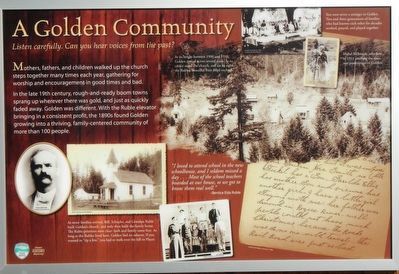
Photographed By Barry Swackhamer, September 27, 2017
3. A Golden Community panel
Captions: (bottom left) As more families arrived, Bill Schuyler, and Grandpa Ruble built Golden's church, and only then built the family home. The Ruble priorities were clear: faith and family came first. As long as the Rubles lived here, Golden had not saloons. It you wanted to "tip a few," you had to walk over the hill to Pacer.; (bottom center) "I loved to attend school in the new schoolhouse, and I seldom missed a day ... Most of the school teachers boarded at our house, so we got to known them real well." - Bernice Elda Ruble; (top center) At its height between 1900 and 1910, Golden spread across serval acres. At its center stood the church, and on its right, the Rubles' beautiful fruit-filled orchard.; (upper right) You were never a stranger in Golden. Two and three generations of families worked, prayed, and played together. Mable McIntosh, seen here in 1911 smelling the roses, was postmasters of Golden.
Credits. This page was last revised on March 23, 2018. It was originally submitted on March 1, 2018, by Barry Swackhamer of Brentwood, California. This page has been viewed 308 times since then and 21 times this year. Last updated on March 21, 2018, by T. Patton of Jefferson, Georgia. Photos: 1, 2, 3, 4, 5, 6. submitted on March 1, 2018, by Barry Swackhamer of Brentwood, California. • Andrew Ruppenstein was the editor who published this page.
